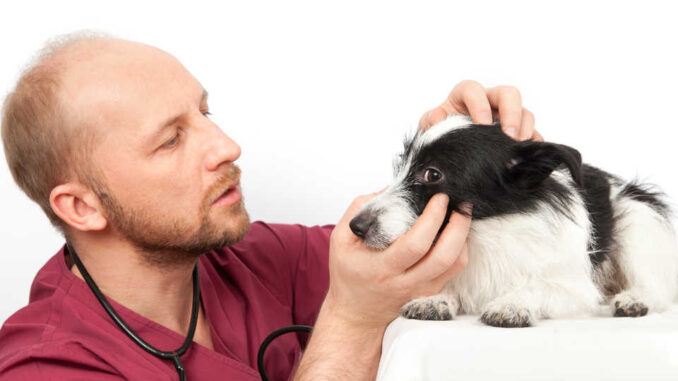
This article was updated on May 5th, 2023
Introduction: about eye cysts in dogs
Finding an unexpected growth or mass on your dog can be distressing, but it is even more so when you notice a growth inside their eye. Though not incredibly common, I often notice a uveal / iris cyst in a dog’s eye at their annual wellness exam. It is always important to have these growths examined by a veterinarian to rule out more serious conditions, such as cancer (Any time that you notice a growth within your dog’s eye, you should make an appointment with their veterinarian as soon as possible).
What is an eye cyst? (uveal or iris cyst)
Also known as an iris cyst or a uveal cyst, an eye cyst is a small fluid-filled structure that is hollow on the inside, typically filled with fluid. These cysts are located along the uveal tract inside the eye, which consists of the iris, the ciliary body, and the choroid. The term iris cyst is truly only accurate for cysts arising from the tissues of the iris, which is the colored part of the eye. Because the iris is easy to see when looking at a dog’s eye, and because these cysts tend to be darkly pigmented, many cysts that owners notice are, in fact, iris cysts. Other uveal cysts are found arising from the other parts of the uveal tract or, in some cases, free-floating inside the eye.
What do eye cysts look like in dogs?
Most commonly, a uveal cyst is found during an ocular examination by a veterinarian. However, owners may notice these growths in the eye as well. The cyst will appear as a small, typically darkly colored mass inside the dog’s eye.
Pictures of eye cysts
Picture 1 – Pictured below is a small uveal cyst floating in the ventral anterior chamber. The cyst is a dark brown, round structure near the inner corner of the eye.
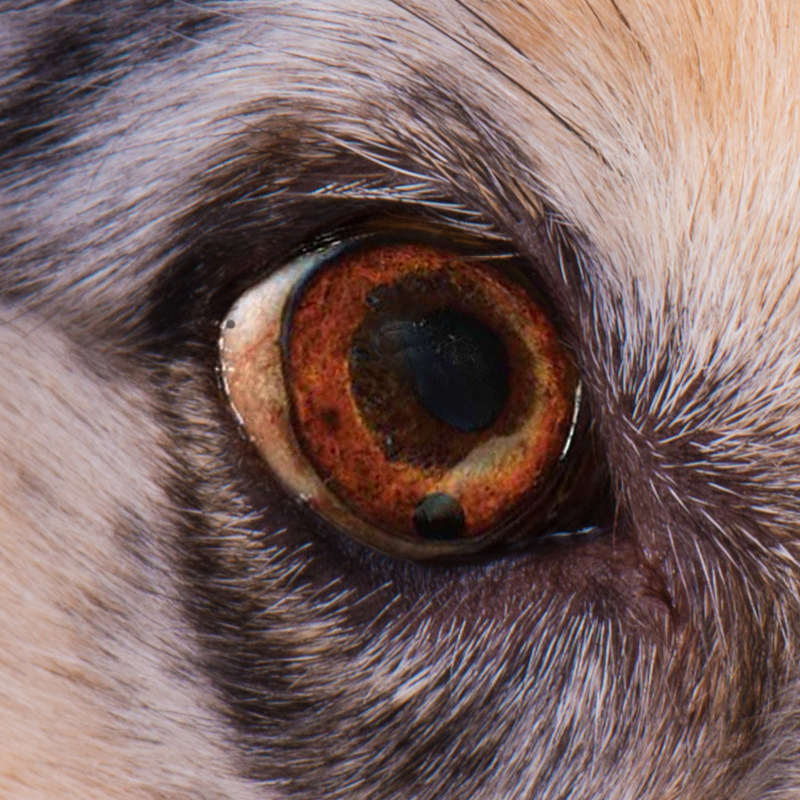
Picture 2 – Pictured is a uveal cyst in the eye of a dog. This cyst is a roundish-oval, translucent dark brown area that appears to be free floating in the anterior chamber:
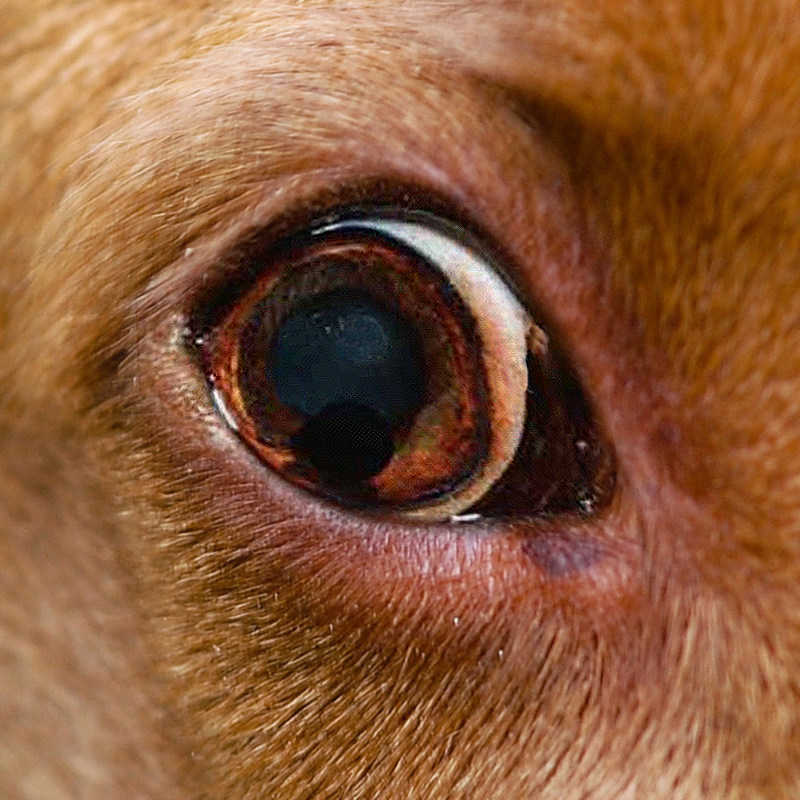
Picture 3 – This image shows a dog with multiple round uveal cysts that appear to have adhered to the cornea. The cysts are translucent gold to dark brown structures that appear to be floating in the middle of the eye.
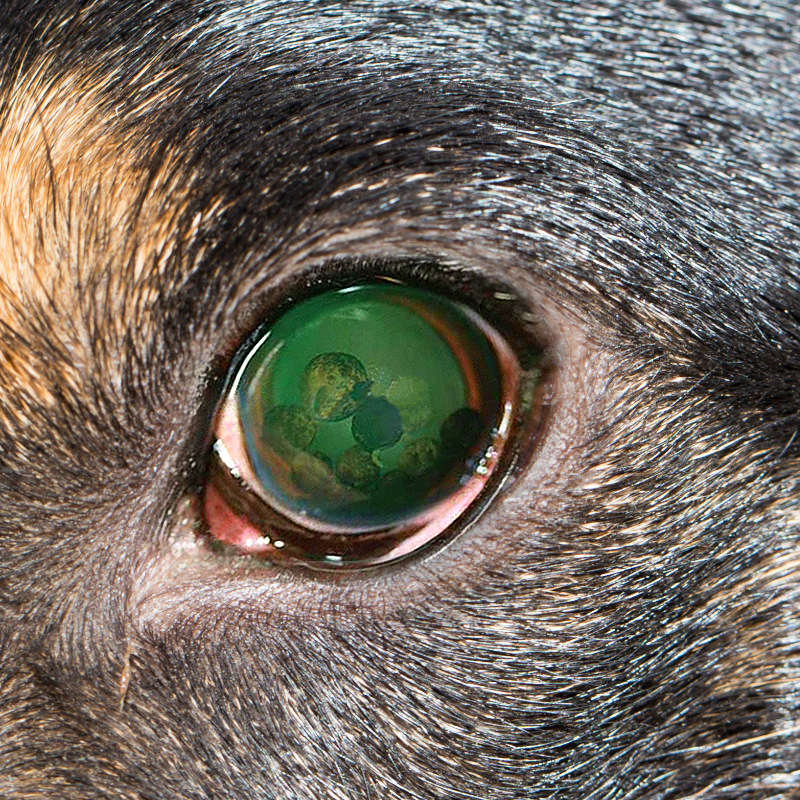
Can I just monitor my dog and wait to see how the cyst evolves?
Unfortunately, taking a “wait and see” approach to a dog’s uveal cyst is a bad idea. For one, it is impossible for an owner to determine whether or not the growth is, in fact, a cyst. Cancerous lesions, such as iris melanoma, have the exact same appearance and can result in the loss of the dog’s eye and death. Additionally, in certain breeds, such as the American Bulldog, Great Danes, Boston Terriers, and Golden Retrievers, the formation of a uveal cyst is highly correlated to the development of blinding uveitis. These cysts require prompt treatment to safeguard the dog’s vision.
Is an eye cyst painful or uncomfortable to the dog?
A genuinely benign uveal cyst is likely not painful for the dog. However, it is possible that the cyst can increase ocular pressures resulting in glaucoma, as well as cause uveitis, which are both painful conditions.
Diagnosis of eye cysts
The first thing your veterinarian will need to do upon noticing a growth in your dog’s eye is to try to determine if it could possibly be cancerous. Uveal cysts appear very similar to melanoma, which is the most common form of eye cancer in dogs. Your veterinarian may refer you and your dog to a board-certified ophthalmologist for testing and treatment. In other cases, if a slit lamp ocular exam reveals that the growth allows light to pass through it, it may be possible for your regular veterinarian to determine that it is a cyst. Some uveal tract growths will require an ocular ultrasound to determine if the growth is a benign cyst or a cancerous mass.
Treatments
Should you treat an eye cyst?
If the growth is proven to be a cyst, there may be no treatment needed. Small cysts that do not impair the dog’s vision may be left alone. Treatment should only be done for cysts that cause an issue, for example when the eye cyst grows to a size that impairs the dog’s vision.
Cysts that are causing an issue will be surgically aspirated (surgery with general anesthesia) or deflated with a diode laser (laser ablation with sedation).
How do you know if your dog’s eye cyst needs intervention?
The only way to tell if it needs surgery or can be left alone is with trans illumination via a slit lamp. This is a complex diagnosis that should be done, in most cases, by an ophthalmologist veterinarian. What can appear to be eye cysts could also be tumors – for instance, melanomas. As a result, it is critical to come up with a correct diagnosis. Visual inspection may not be enough.
Treatment and surgery
Typically, these advanced procedures on the eye will only be performed by a board-certified veterinary ophthalmologist. The price will typically range from $800-$2,000, depending on the size and location of the cyst. Because this surgery is minimally invasive, most dogs recover remarkably well.
Remember to apply all eye medications as well as to give any prescribed oral medications as directed by the veterinarian. Keep the dog calm, and do not allow them to rub or scratch at the affected eye.
What causes uveal or cysts in dogs?
Though the exact cause is unknown at this time, in certain breeds, there appears to be a genetic predisposition. In other dogs, an abnormality in the eye’s conformation and structure, as well as inflammation within the eye, may be to blame.
Is there anything that dog owners can do to prevent future cysts?
In general, it may be a good idea not to breed dogs that have a history of uveal cysts to avoid the passing of the genetic predisposition to future generations. Individual dogs with a history of uveal cysts should receive a comprehensive eye examination with their veterinarian or a veterinary ophthalmologist twice yearly.
If a dog has a cyst, does it mean they are more likely to get a cyst again?
New cysts may form if a dog has a genetic predisposition to the formation of uveal cysts, an abnormal eye anatomy, or an eye condition that causes inflammation. In these cases, it is imperative to have the dog’s eyes examined at least every six months by a veterinarian.
Related posts:
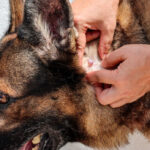 Types of Cysts Often Found on a Dog’s Neck or Head [Vet Advice] - Canine cysts of the head and neck are fairly common and most of them don’t cause serious problems. There are… [...]
Types of Cysts Often Found on a Dog’s Neck or Head [Vet Advice] - Canine cysts of the head and neck are fairly common and most of them don’t cause serious problems. There are… [...] 4 Cysts Often Found on Dog Paws [With Pictures & Vet Advice] - Ahh dog feet, giant Great Dane Marmaduke paws, tiny terrier tootsies, the puffy, fluffy white feet of a Bichon Frisé.… [...]
4 Cysts Often Found on Dog Paws [With Pictures & Vet Advice] - Ahh dog feet, giant Great Dane Marmaduke paws, tiny terrier tootsies, the puffy, fluffy white feet of a Bichon Frisé.… [...] Eyelid Cysts in Dogs: FAQ With Our Veterinarian - Eyelid cysts are very common, particularly in older dogs. Oftentimes, an owner is unaware that they’re present as they can… [...]
Eyelid Cysts in Dogs: FAQ With Our Veterinarian - Eyelid cysts are very common, particularly in older dogs. Oftentimes, an owner is unaware that they’re present as they can… [...] Burst or Ruptured Cysts on Dogs: Our Vet Shares What to Do - When a dog does come into my clinic with a ruptured cyst, the owner can be quite alarmed by the… [...]
Burst or Ruptured Cysts on Dogs: Our Vet Shares What to Do - When a dog does come into my clinic with a ruptured cyst, the owner can be quite alarmed by the… [...] Dog Hair Follicle (Follicular) Cysts: Pictures + Vet FAQ - It is extremely common for dogs to develop lumps and bumps anywhere on their body. They can range in size,… [...]
Dog Hair Follicle (Follicular) Cysts: Pictures + Vet FAQ - It is extremely common for dogs to develop lumps and bumps anywhere on their body. They can range in size,… [...]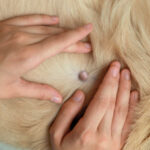 6 Types of Cysts in Dogs [With Pictures], and How to Treat - As a practicing veterinarian for over 17 years, I have treated hundreds of dogs with cysts. Cysts are a very… [...]
6 Types of Cysts in Dogs [With Pictures], and How to Treat - As a practicing veterinarian for over 17 years, I have treated hundreds of dogs with cysts. Cysts are a very… [...] Sebaceous Cysts in Dogs [Pictures & Veterinarian Advice] - Sebaceous Cysts in dogs is one health issue for which dog owners should be watchful, but thankfully, they are rarely… [...]
Sebaceous Cysts in Dogs [Pictures & Veterinarian Advice] - Sebaceous Cysts in dogs is one health issue for which dog owners should be watchful, but thankfully, they are rarely… [...]Disclaimer: This website's content is not a substitute for veterinary care. Always consult with your veterinarian for healthcare decisions. Read More.


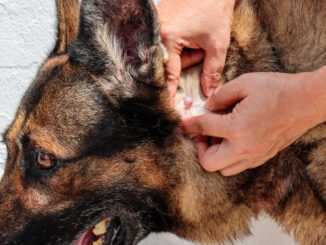
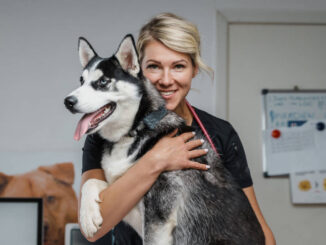
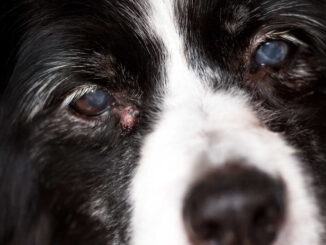
Be the first to comment